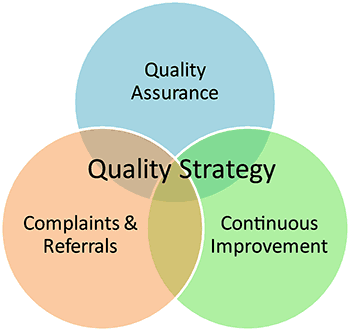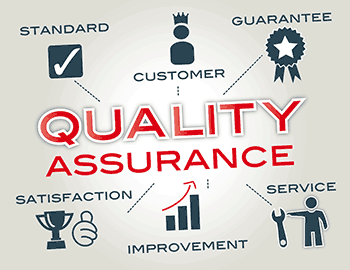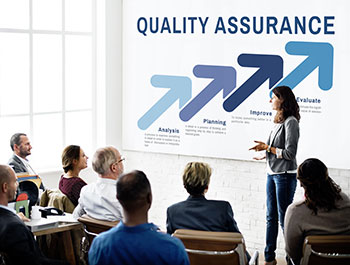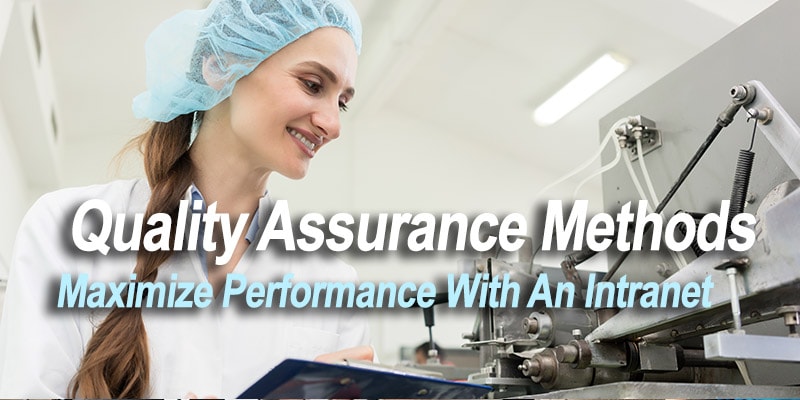Whether your business produces goods or services, you will rightly be focussed on providing a consistent, high quality output to your customers. After all, that is the key to customer acquisition as well as retention, and ultimately leads to increased profits. Simply put, quality assurance is the end-to-end process of monitoring and evaluating the performance of products or services. It’s what you need to do to ensure you consistently achieve a high quality output. There are various quality assurance methods out there and for some businesses it happens by chance more than by design. So, if your business has tended to approach quality assurance in a somewhat haphazard fashion, then it’s definitely time to get more organized.
Simply put, quality assurance is the end-to-end process of monitoring and evaluating the performance of products or services.
 The good news is that the company intranet can support you along the way. In this post, we look at some common quality assurance methods and we set out how an intranet can help.
The good news is that the company intranet can support you along the way. In this post, we look at some common quality assurance methods and we set out how an intranet can help.
Definition Of Quality Assurance
Before we get into the detail, it’s always a good idea to define your terms so that we are on the same page. The American Society for Quality defines quality assurance as follows:
The planned and systematic activities implemented in a quality system so that quality requirements for a product or service will be fulfilled.
Quality assurance methods, therefore, tend to be process driven and are primarily focussed on the development of the product or the delivery of a service.
Why Quality Assurance Is Important
It’s important for a variety of reasons including:
- ensuring customer expectations are satisfied
- enhancing a company’s brand reputation
- controlling costs.
As well as helping to maintain customer satisfaction and loyalty, quality assurance methods will also reduce the costs of replacing faulty goods or refunding customers unhappy with the level of service. Having a quality product will not only help on the customer acquisition and retention front, it also means that you can charge premium prices for your product or service.
 Furthermore, the reach of social media means that customers can easily share both good and bad reviews of your product and services. Before you know it, a slip up on the quality assurance front could easily go viral with many thousands or even millions being exposed to a poor review in just a matter of minutes. The fall-out can be costly both in terms of your brand authority and reputation in the marketplace, and in relation to customers or prospects jumping ship in favour of the competition. A product recall campaign because of poor quality assurance methods could be catastrophic in terms of negative publicity and damage to your reputation. And in serious cases, you could even incur legal costs.
Furthermore, the reach of social media means that customers can easily share both good and bad reviews of your product and services. Before you know it, a slip up on the quality assurance front could easily go viral with many thousands or even millions being exposed to a poor review in just a matter of minutes. The fall-out can be costly both in terms of your brand authority and reputation in the marketplace, and in relation to customers or prospects jumping ship in favour of the competition. A product recall campaign because of poor quality assurance methods could be catastrophic in terms of negative publicity and damage to your reputation. And in serious cases, you could even incur legal costs.
Quality assurance methods will help you to avoid all these potential problems. Continuous assessment, review, and action will see you achieving a consistently high, quality output that meets customers’ expectation.
Quality Assurance Vs. Quality Control
The terms quality assurance and quality control are often used interchangeably but actually mean different things. Before we go further, let’s be clear about how they differ.
Perhaps the key difference between the two processes is that quality assurance takes place during the process and seeks to ensure that the product or service meets the required quality standards. Quality control, on the other hand, is performed after the product has been manufactured or the service has been delivered. It seeks to evaluate whether quality standards have been satisfied.
Examples Of Quality Assurance Methods
Google ‘quality assurance methods’ and you will see that there are plenty of choices out there. Here are just some of the most popular quality assurance methods and processes:
 Benchmarking
Benchmarking- Business process re-engineering
- Kaizen
- Operations analysis
- ISO accreditation
- Ishikawa diagrams
- Specifications
- Standard operating procedures
- Cost-benefit analysis
- Statistical sampling
- Quality management methodologies e.g. Six Sigma, Lean Manufacturing
The chances are your business is currently using at least one of these tools, even if you haven’t formally labelled it as a quality assurance process. Some methodologies are more involved than others; however, whichever one you select, the company intranet can simplify the processes involved for a speedier and more effective outcome. Let’s find out how exactly.
Customer Involvement In Quality Assurance Methods
The starting point for any process aimed at improving quality has to be customer involvement. The output in terms of product or service has to satisfy consumers’ expectations on quality. Developing two-way conversations with existing customers via a customer portal will be critical to the success of any quality assurance method and will help you to determine the minimum quality standards you need to achieve.
Develop a customer portal within the intranet and invite customers to log any issues or problems. Encourage discussion on quality issues on the portal or even invite views on quality issues through a customer survey.
The customer portal also gives you the opportunity to report to customers on any improvements or innovations that you have made as a result of their feedback. It’s a great vehicle for facilitating an honest and open dialogue while also harvesting valuable insights that will inform the quality assurance process.
Documenting Your Processes
Every quality assurance system has at its heart clearly documented processes and detailed specifications. Consider for a moment that you are in the cookie-making business. Having surveyed your consumers, you come up with the ideal cookie that will be a big hit on the market. It needs to be of a specific size and texture and it must include chocolate chips. To ensure all your cookies meet the required standards and customer expectations, you need to not only document the recipe which is the process required to get there, you also need to clearly specify down to every detail including the diameter of the cookie, exactly what the end product will look like.

The only way to ensure that your cookie-making processes are consistent is to document the steps needed to get there. It’s only through process documentation that you can check whether the output matches the required quality standard.
And rather than cumbersome error-prone paper systems, online documentation stored on the company intranet is the way to go. A wealth of information and data is literally available at your fingertips. Moreover, processes change, new technology is implemented and different operating systems are introduced. Updating your team’s process documentation on the intranet is a straightforward task and staff members can be confident that they are accessing the very latest information on the intranet. And if a flaw in the process is identified at any stage, the intranet makes it easy to quickly roll the fix out across the entire organization.
Process Checklists
One of the most common quality assurance techniques are process checklists. These are a useful tool for ensuring all the essential steps involved in the manufacturing process or delivery of a service have been satisfactorily completed. A process checklist means that no step is inadvertently missed.
 However, instead of setting up a paper-based process with its inherent inefficiencies and potential for error, use the intranet’s in-built forms builder or an embedded Google Form to develop your checklist. It’s easy to get started using fully customizable drag and drop functionality with integrated actions, rules, email notifications, and submission reports. In addition, some manufacturing processes may take place off-site and the advantage of an online checklist is that it can be completed remotely via a smartphone or tablet. What’s more, the intranet will automatically route the completed checklist to the correct member of staff for further action.
However, instead of setting up a paper-based process with its inherent inefficiencies and potential for error, use the intranet’s in-built forms builder or an embedded Google Form to develop your checklist. It’s easy to get started using fully customizable drag and drop functionality with integrated actions, rules, email notifications, and submission reports. In addition, some manufacturing processes may take place off-site and the advantage of an online checklist is that it can be completed remotely via a smartphone or tablet. What’s more, the intranet will automatically route the completed checklist to the correct member of staff for further action.
An online intranet-enabled checklist gives management complete oversight of the process. Any bottlenecks or processes that are below par for whatever reason can be quickly picked up and rectified by management.
Process Reviews
Many companies undertake regular process reviews as part of their approach to quality assurance. It certainly makes sense to regularly check in on production processes as the operating environment is constantly changing, new technology or systems are being introduced, even changes in key personnel can impact on quality assurance.
 All managers – either as individuals or in collaboration with their team members or fellow managers – should regularly review production processes or service delivery to ensure assurance standards are being met satisfactorily. In addition, it’s a good idea to benchmark your performance against industry standards and best practices. It also means that your operations and processes remain up to date and don’t lag behind the competition.
All managers – either as individuals or in collaboration with their team members or fellow managers – should regularly review production processes or service delivery to ensure assurance standards are being met satisfactorily. In addition, it’s a good idea to benchmark your performance against industry standards and best practices. It also means that your operations and processes remain up to date and don’t lag behind the competition.
An intranet can facilitate and support process reviews. Set up a project workspace within the intranet for key personnel to share insights, brainstorm ideas and collaborate on developing their performance review techniques or workflows. Embed G Suite apps directly in the intranet and group members can simultaneously work on files and protocols in real time, with the intranet automatically saving the very latest version. Access to the workspace can be restricted to only relevant staff by applying the intranet site’s access rules. Use the workspace to share industry best practice and benchmarking data.
And once the process review has been completed, you can use the intranet’s news feed to publicize the outcomes and action plan to team members or managers.
Managing Quality Assurance Data And Information
All the quality assurance methods we identified earlier have one thing in common: they generate a great deal of data and information that needs to be organized and managed. Whether it’s detailed specifications that control production, standard operating procedures or benchmarking data, the information all needs to be readily accessible and easily located.
The intranet’s in-built file and document storage function is the perfect vehicle for managing all this data. With a familiar file explorer interface, unlimited numbers of files and folders as well as advanced search functionality, staff can quickly and easily locate quality assurance information with just a few clicks of the mouse. What’s more, the data is stored in the cloud which means it is accessible 24/7 and is available to staff that might be based in satellite offices other than head office.
Furthermore, unlike paper-based, manual filing systems there’s no need to ensure that outdated versions of documents or data sets are removed and destroyed. With an electronic content management system, staff members can be confident they are accessing the very latest information.
Quality Assurance Staff Training
A big element of any successful quality assurance program is ongoing staff training and support. After all, it’s your employees who will be implementing the quality standards and ensuring that they are met. Your quality assurance system will quickly fall down if the staff members at each step of the production or delivery process fail to fully understand their roles or perform them consistently.
 Staff training and support is therefore critical to the entire process and the intranet is the perfect platform for achieving it. Whether it’s onboarding and induction of new staff or ongoing refresher training for existing team members, you can take your pick from the intranet’s online tutorials and how-to videos, wikis or webinars. Or for staff that prefer more traditional media how about checklists, questionnaires, surveys and guides. The intranet offers the potential for a variety of training media to suit all learning styles and preferences. And the best part is that because it’s cloud-based, the training doesn’t have to be completed in the workplace. Staff can logon to the intranet and complete a module at a time and place that is convenient for them. What’s more, the intranet will automatically log completed training modules and can report to management on progress for monitoring and compliance purposes.
Staff training and support is therefore critical to the entire process and the intranet is the perfect platform for achieving it. Whether it’s onboarding and induction of new staff or ongoing refresher training for existing team members, you can take your pick from the intranet’s online tutorials and how-to videos, wikis or webinars. Or for staff that prefer more traditional media how about checklists, questionnaires, surveys and guides. The intranet offers the potential for a variety of training media to suit all learning styles and preferences. And the best part is that because it’s cloud-based, the training doesn’t have to be completed in the workplace. Staff can logon to the intranet and complete a module at a time and place that is convenient for them. What’s more, the intranet will automatically log completed training modules and can report to management on progress for monitoring and compliance purposes.
Quality Assurance Made Easy With An Intranet
Managing quality is a crucial process for any business. Ensuring that you have a consistently high-quality product or service translates into satisfied customers, increased sales and ultimately more dollars in the bank. In today’s very competitive marketplace, having a reputation as a high-performing, quality business could be a critical differentiator for your company.
And when it comes to implementing quality assurance methods, the company intranet makes the process a whole lot easier.
Interested in finding out more about how an intranet could support quality assurance methods in your business? Get in touch with us here at MyHub. Our easy to setup and manage cloud intranet templates will deliver on a broad range of business operations and processes. Explore the possibilities with a free demo or a 14-day no obligation trial. Contact us today!







Hello, I love your website! I can totally relate to your point as I work as a pharmacy and insurance liaison for a BPO provider.